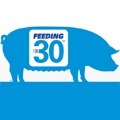 In sow facilities, longevity is key. The longer a sow stays in the herd, the more potential she has to reach – and exceed – her breakeven point. New research shows many sows are leaving the U.S. sow herd at a young age – a problem potentially linked to low feed intake in lactation.
In sow facilities, longevity is key. The longer a sow stays in the herd, the more potential she has to reach – and exceed – her breakeven point. New research shows many sows are leaving the U.S. sow herd at a young age – a problem potentially linked to low feed intake in lactation.
 That’s according to Zach Rambo, swine nutritionist for Zinpro Corporation.
That’s according to Zach Rambo, swine nutritionist for Zinpro Corporation.

Rambo references a recent survey of Midwest facilities to show early fallout in sow herds. In the data set (figure 1) more than 10 percent of females never farrowed, while another large percentage weaned fewer than 20 pigs lifetime due to early culling.
“If sows are culled in parity 1, parity 2 or before, they have yet to reach their breakeven point,” Rambo says. “That’s an awfully expensive investment that you’ve now lost money on.”
“We need to focus on avoiding the ‘freshman fallout’ and the ‘Parity 2 dip,’” Rambo adds. “If we can help sows reach parity 3, that’s where they’ll start making returns to the herd.”
Why are sows culled early?
To fix a problem, we first need to understand the cause.
“The big question is: why do we cull sows?” Rambo asks. “Something we’d like to see more of is culling based on age rather than culling out of necessity. If you’re removing a sow from a herd because of age, that’s voluntary.”
 In contrast, sows culled based on performance or lameness are involuntary culls. A recent study by the National Animal Health Monitoring System (NAHMS) estimated nearly 30 percent of sows are culled involuntarily (15.2% for lameness and 13.0% for performance as shown in figure 2). Rambo recognizes these culls as areas that can be avoided through nutrition and management.
In contrast, sows culled based on performance or lameness are involuntary culls. A recent study by the National Animal Health Monitoring System (NAHMS) estimated nearly 30 percent of sows are culled involuntarily (15.2% for lameness and 13.0% for performance as shown in figure 2). Rambo recognizes these culls as areas that can be avoided through nutrition and management.
Preventing early culls
“Two focus points to help keep sows in the herd are: reducing lameness and improving lactation feed intake,” Rambo says. “If you can take care of these two things, you can help mitigate a lot of problems that you see in large production systems.”
One way to mitigate lameness is to feed rations with optimized trace minerals through all production phases, helping prevent lameness before it begins.
Improving lactation feed intake is the next step. After farrowing, increase feed levels quickly. Any restriction of feed intake during lactation – whether from lack of appetite or a conservative feeding program – can increase sow weight loss and may decrease reproductive efficiency, contributing to greater culling potential.
“If we can feed sows to minimize lameness and weight loss, we can then improve reproductive performance and help them achieve their genetic potential,” Rambo says.
MAy 19, 2015 - Feeding for 30



